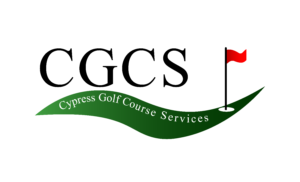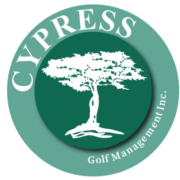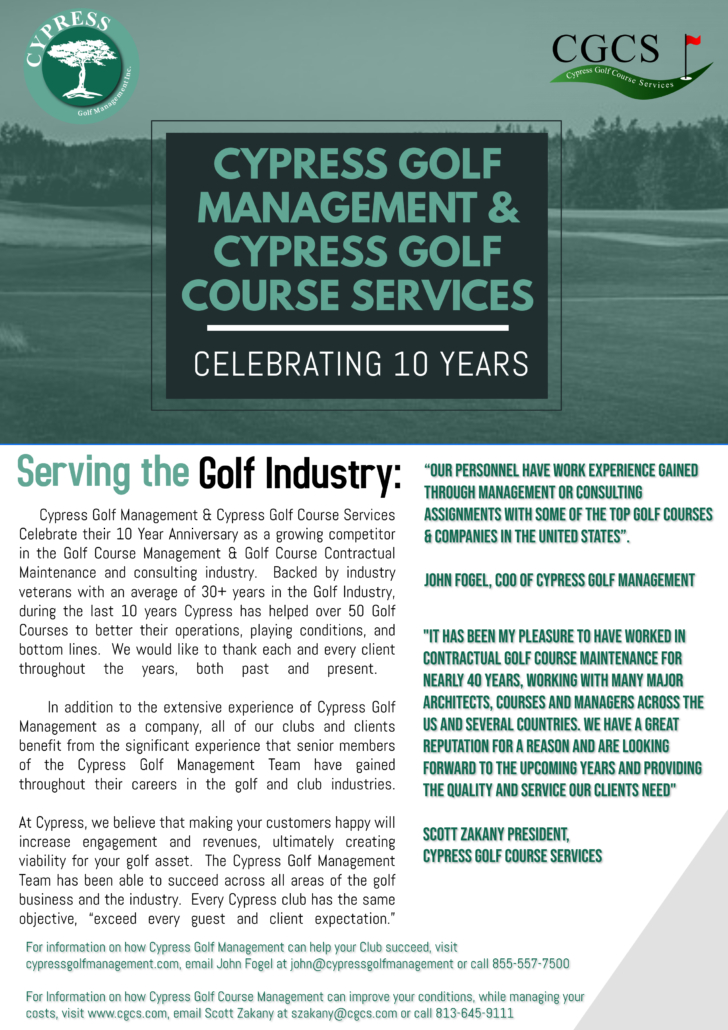While outsourcing or contracting maintenance has been around for 40 years, it still seems that the concept is new to a lot of people. Outsourcing is simply put as:
“Having a company provide all the materials, supplies and equipment that is needed to take care of the golf course maintenance operations at a facility on a daily basis”.
Think about it like the landscaping industry. The landscape industry evolved with a full-service account that mows, edges, blows, and takes care of the grounds including all labor, pest control, fertilization, equipment, and materials that are needed to perform this service. In order to manage the expectations of this landscape service, there is usually a set of standards or specifications that are agreed upon at the time of hire. The more detailed the standards and specifications, the more precise the company can deliver the standards. This works the same way in a golf course maintenance operation! A club develops a set of standards, and the maintenance company provides an annual price to live up to these standards that are set. A fixed cost and precise delivery of service takes the guesswork out of an ever fluctuating maintenance budget and the labor burden that is involved with it.
How long has it been since you had an outside analysis of your Maintenance operation? Golf course owners and operators can have a third party analysis on where their individual club is positioned in the current business environment. At CGCS, we take a comprehensive approach to ensuring that a club is properly positioned in its marketplace.
Cypress Golf Course Services If you have any questions, comments, article ideas or would like to discuss the services CGCS provides please do not hesitate to email me at [email protected] or call (941) 747-5059
When your followers mention or share your brand online, engaging with them poses an excellent opportunity to encourage them to refer their friends to you. Your interaction can appear on their friends’ feeds and build your reach!
Many of your followers on social media are already fans of your brand! They are the Cheerleaders you always wanted but didn’t know you had.
Those unofficial brand ambassadors are your key to winning online. Personal invitations from your Golfers to their social circle is key! Try Hosting Monthly New Member/Golfer receptions or free clinics to help them promote you to their friends!
Cypress Golf Course Service (CGCS) is very aware of being sensitive to the environment. With the attention that fertilizers and pesticides golf courses use to maintain them under constant scrutiny, having a committed environmental plan by the maintenance department is essential. While there are several ways to approach the maintenance of a golf course, taking additional steps to ensure the health of the environment and the surrounding area is a practinot all management companies subscribe to.
 As a partner of the Audubon Sanctuary for Golf Courses, our commitment to the environment is something that we take seriously.
As a partner of the Audubon Sanctuary for Golf Courses, our commitment to the environment is something that we take seriously.
What are My Course’s Environmental Opportunities and how can CGCS help?
· Preserve natural areas within urban environments
· Provide needed wildlife sanctuaries
· Support plants and wildlife native to the area
· Protect water resources
· Filter stormwater runoff through golf course wetlands and turfgrass
· Rehabilitate degraded landscapes
· Educate golfers and the general public about the nature of the game and promote environmentally-sound management
Golf Courses offer numerous opportunities to not only provide pleasant places to play, but also to protect drinking water, improve the water quality of our lakes, streams, and rivers, support a variety of plants and wildlife, and protect our environment for future generations.
If you have any questions, comments, article ideas or would like to discuss the services CGCS provides please do not hesitate to email me at [email protected] or call (941) 747-5059

Surveys conducted* by the Golf Course Superintendents Association of America (GCSAA) reveal that labor accounts for 52 percent to 65 percent of a course operation’s total budget. The surveys only generalize the relative size of this budget line item but do not reveal the challenges of the tasks themselves: the course design requirements and the relative handwork necessary to achieve them. Typically, labor costs are the primary focus for immediate cost constrictions without consideration given to the ramifications of such reductions.
The only reliable method to determine the cost of labor is to examine the tasks required of the human capital employed to execute them, individually and dynamically. Employee productivity, time and motion studies, manpower estimates: they all refer to studying tasks and the cost of labor required to complete them.
The goal of these studies is to determine how many full-time employees (FTE) are necessary to complete all the tasks required to maintain the course objectives and benchmark standards. An FTE is defined as one person working 40 hours per week for 52 weeks for a total of 2,080 hours.
| Evaluated tasks: Actual hours | |||||||||||
| Task |
| Hours |
| Frequency |
| Per |
| Total Time per week |
| ||
|
|
|
|
|
|
|
|
|
|
|
|
|
| Task A |
| .75 |
| 2 |
| week |
|
| 2.25 |
|
|
| Task B |
| 1.25 |
| 1 |
| day |
|
| 8.75 |
|
|
| Task C |
| .5 |
| 1 |
| day |
|
| 3.5 |
|
|
| Task D |
| .75 |
| 2 |
| day |
|
| 10.5 |
|
|
| Task E |
| .5 |
| 3 |
| week |
|
| 1.5 |
|
|
| Task F |
| 32 |
| 5 |
| week |
|
| 160 |
|
|
| Task G |
| 16 |
| 8 |
| week |
|
| 128 |
|
|
| Task H |
| 7 |
| 12 |
| Day |
|
| 588 |
|
|
| Total hours per week |
|
|
|
|
|
|
|
| 902.5 |
|
|
| Total hours per year |
|
|
|
|
|
|
|
| 46,930 |
|
|
| FTE ( 2080) |
|
|
|
|
|
|
|
| 22.5625 |
|
|
When the total number of FTEs is defined for existing tasks, it should be compared to the proposed benchmarks to determine what efficiencies are lost or gained applying alternate maintenance practices and procedures. Labor costs are then assigned, per employee, to actual hours and required hours to determine where changes in the operation should be initiated and how those changes will affect labor cost projections.
As always, maintaining the benchmark standards is the focus of all labor cost evaluations. It is important to be cognizant of manpower reductions and changes that could have a long-term negative impact on the course conditions and playability. Staff required for each task or project is frequently misrepresented because the exact time requirements are estimated or unknown. Staff is often expected to do more, with fewer resources, or experiences idleness as a result of undefined expectations.
Labor cost is a significant portion of any club’s budget, and course maintenance accounts for the majority of that cost. Course maintenance is also the most visible and impactful for membership, both in terms of aesthetics and enjoyment. Additionally, what works for one club may not work for another, even clubs that are similar in geography or player demographics; no two clubs can compare or duplicate labor utilization and cost.
The principles at CGCS have the expertise to complete a proper labor analysis, having personally owned, operated, and managed course operations. We provide the solutions you need to manage maintenance operations as a business within your business. If you would like more information about this type of analysis, or any other service that will allow your club to run more efficiently and more profitably, call us at (813) 645-9111 or send an email from our contact page.
Interesting links
Here are some interesting links for you! Enjoy your stay :)Apollo Beach
Cypress Golf Course Services
235 Apollo Beach Blvd, #422
Apollo Beach, FL. 33572












